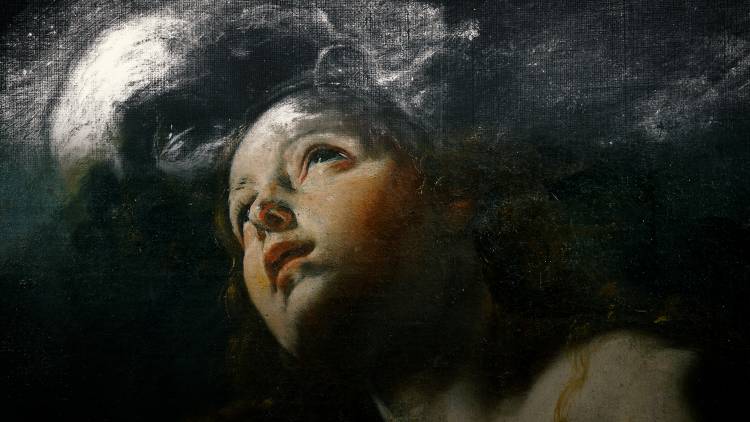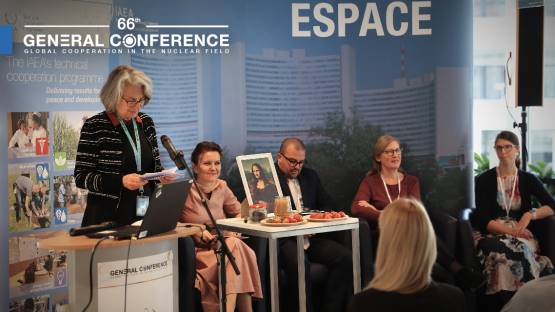During an analysis of Vincent van Gogh’s artwork ‘Head of a Peasant Woman,’ art conservators at the National Galleries of Scotland made a surprising discovery: a self-portrait of the painter was hidden underneath layers of glue and cardboard. The discovery was possible thanks to nuclear non-destructive testing (NDT), a method involving X-rays used to detect the presence and measure the concentration of elements in virtually all types of material.
From Ancient Artefacts to Slovenian Truffles: Revealing Secrets Using Nuclear Techniques
Attendees at the event ‘Revealing Secrets Using Nuclear Techniques,’ held during IAEA’s 66th General Conference, were given an overview of the ways in which nuclear techniques can be used to investigate the composition and origin of historical objects. (Photo: A. Vlasov/IAEA)
X-ray fluorescence (XRF) was one of several nuclear analytical techniques discussed today by participants of the event ‘Revealing Secrets Using Nuclear Techniques,’ held during IAEA’s 66th General Conference, to showcase the potential of nuclear techniques in uncovering secrets of both the past and the present.
Attendees also heard about the applicability of NDT in various domains, from investigating the composition and origin of historical objects to revealing fraud and verifying the authenticity of paintings, food and timber.
In the field of cultural heritage, non-destructive testing techniques, allow researchers to assess the integrity and physical properties of objects without damaging them, in contrast to traditional chemical analytical methods, which has proved valuable to restorers when dealing with historical artefacts and other valuable or fragile pieces.
"Cultural heritage objects contain within their building blocks information that can only be unravelled by scientific analysis and examination," said Matthew Grima, forensic scientist and manager at the Heritage Malta's Diagnostic Science Laboratories. "It is thus fantastic to be able to apply them also in a non-destructive way, sourcing the information without damaging the object."
At the event, attendees learned that accelerator-based techniques, like ion beam analysis (IBA) can be applied to determine the composition of cultural artefacts, such as paintings. For instance, it is possible to get analytical information from the sub-surface of a painting, in addition to the X-ray fluorescence spectroscopy data provide analytical information from the surface. The combination of these techniques revealed that the sfumato technique, a fine shading artistic technique perfected by Leonardo da Vinci, was used to produce a soft transition between colours and tones to achieve a realistic impression in several renaissance paintings, including the Mona Lisa.
“This example shows that accelerator and portable systems are complementary nuclear based-techniques for NDT of paintings and more generally for cultural heritage materials,” said Lucile Beck, researcher in cultural heritage at the French Alternative Energies and Atomic Energy Commission (CEA).

Using x-radiography to uncover hidden paintings. (Photo: Heritage Malta)
Radiocarbon dating, an additional accelerator-based nuclear analytical technique, has been used to determine the age of cultural heritage items by examining the decay of the radioactive isotope carbon-14 to reveal how old artefacts are or the order in which certain events happened.
An additional outstanding capability of accelerator-based analytical techniques is to determine the composition, structure, age of cultural artefacts, which in turn can be used to identify their origin, trading routes and reveal forgeries.
Attendees also gained insight into the application of nuclear analytical techniques in other areas, such as the traceability and authenticity of food. In this field, the use of stable isotope analysis can provide evidence of food adulteration or substitution, and verify the geographical origin of food products.
Pointing out the important role of nuclear techniques in assessing the authenticity of food, particularly those with high-value labelling claims, Lidija Strojnik, researcher at the Josef Stefan Institute in Slovenia, said: “Food fraud is a big global issue since it affects 10 per cent of the global food supply and costs the global industry between USD30 to 40 billion every year. The use of stable isotopes opens up new possibilities to detect food fraud in the supply chain, such as mislabelling of the country of origin of food crops and adulteration of natural flavours with cheaper synthetic counterparts.” In Slovenia, fraudulent truffes, the world’s most expensive food, were identified through an isotope analysis.
The versatile applications of nuclear analytical techniques were emphasized by all participating experts, who discussed the breadth of their utility, which even extends to countering and monitoring environmental issues. Participants also learned that isotopic techniques can be used to counter deforestation by tracing the origin of timber and revealing illegal logging, and to uncover and predict the source of greenhouse gases in the atmosphere.
The IAEA last week launched a coordinated research project (CRP) on the development and implementation of cultural heritage preservation using ionizing radiation technology. To find out more about the CRP click here.





